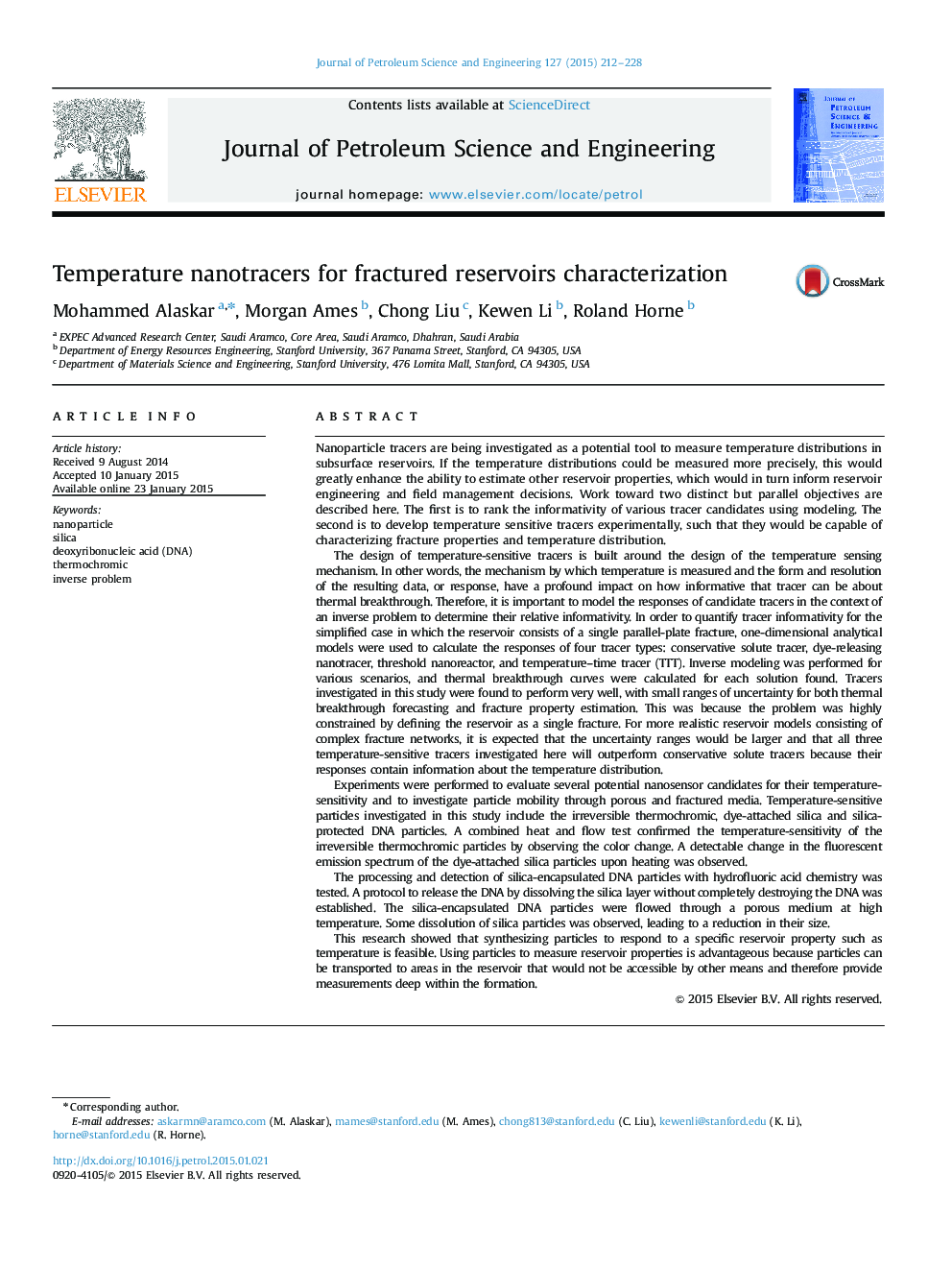| کد مقاله | کد نشریه | سال انتشار | مقاله انگلیسی | نسخه تمام متن |
|---|---|---|---|---|
| 1754869 | 1522814 | 2015 | 17 صفحه PDF | دانلود رایگان |
• Nanoparticles investigated as tool to measure temperature in subsurface reservoirs.
• Analytical models were developed to rank the informativity of various tracers.
• We develop and test temperature tracers, each with a different sensing scheme.
• Results show that carefully designed temperature-sensitive nanomaterials are promising candidates for the analysis of fractured reservoirs.
Nanoparticle tracers are being investigated as a potential tool to measure temperature distributions in subsurface reservoirs. If the temperature distributions could be measured more precisely, this would greatly enhance the ability to estimate other reservoir properties, which would in turn inform reservoir engineering and field management decisions. Work toward two distinct but parallel objectives are described here. The first is to rank the informativity of various tracer candidates using modeling. The second is to develop temperature sensitive tracers experimentally, such that they would be capable of characterizing fracture properties and temperature distribution.The design of temperature-sensitive tracers is built around the design of the temperature sensing mechanism. In other words, the mechanism by which temperature is measured and the form and resolution of the resulting data, or response, have a profound impact on how informative that tracer can be about thermal breakthrough. Therefore, it is important to model the responses of candidate tracers in the context of an inverse problem to determine their relative informativity. In order to quantify tracer informativity for the simplified case in which the reservoir consists of a single parallel-plate fracture, one-dimensional analytical models were used to calculate the responses of four tracer types: conservative solute tracer, dye-releasing nanotracer, threshold nanoreactor, and temperature–time tracer (TTT). Inverse modeling was performed for various scenarios, and thermal breakthrough curves were calculated for each solution found. Tracers investigated in this study were found to perform very well, with small ranges of uncertainty for both thermal breakthrough forecasting and fracture property estimation. This was because the problem was highly constrained by defining the reservoir as a single fracture. For more realistic reservoir models consisting of complex fracture networks, it is expected that the uncertainty ranges would be larger and that all three temperature-sensitive tracers investigated here will outperform conservative solute tracers because their responses contain information about the temperature distribution.Experiments were performed to evaluate several potential nanosensor candidates for their temperature-sensitivity and to investigate particle mobility through porous and fractured media. Temperature-sensitive particles investigated in this study include the irreversible thermochromic, dye-attached silica and silica-protected DNA particles. A combined heat and flow test confirmed the temperature-sensitivity of the irreversible thermochromic particles by observing the color change. A detectable change in the fluorescent emission spectrum of the dye-attached silica particles upon heating was observed.The processing and detection of silica-encapsulated DNA particles with hydrofluoric acid chemistry was tested. A protocol to release the DNA by dissolving the silica layer without completely destroying the DNA was established. The silica-encapsulated DNA particles were flowed through a porous medium at high temperature. Some dissolution of silica particles was observed, leading to a reduction in their size.This research showed that synthesizing particles to respond to a specific reservoir property such as temperature is feasible. Using particles to measure reservoir properties is advantageous because particles can be transported to areas in the reservoir that would not be accessible by other means and therefore provide measurements deep within the formation.
Journal: Journal of Petroleum Science and Engineering - Volume 127, March 2015, Pages 212–228
